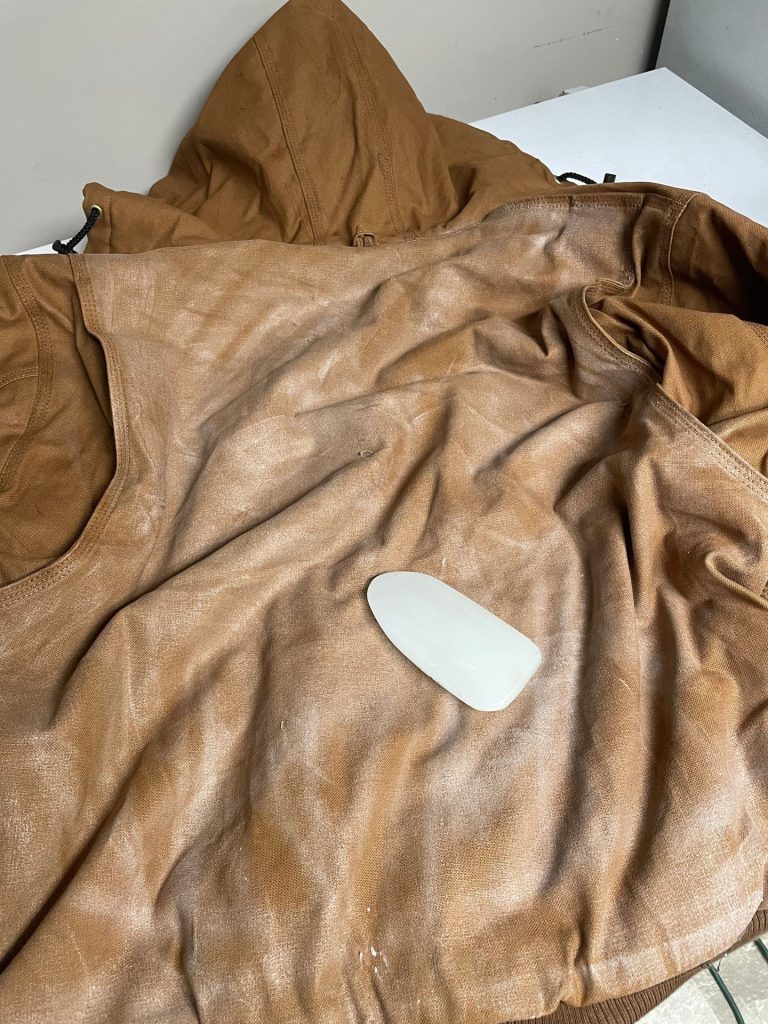
“If you want something done well, do it yourself.” ~Napoleon (perhaps apocryphal)
I recently was blessed to come across a treasure trove of Walls workwear jackets for a fraction of their usual price.

As you can see from the picture above, I paid 9 dollars for this jacket when the original price was basically 60. If it was a Carhartt, I would have ended up paying over 100.
It was so cheap, I bought a second one, because at this price I knew I’d want one that I could wax and wear in the rain and another for less trying occasions.
Waxed jackets, and waxed clothing, in general, are iconic and functional. Waxed coats are produced commercially by Barbour and Filson (Filson calls their material “tin cloth”) and they are excellent in the rain and in other inclement weather.
A well-waxed jacket is an heirloom and will keep you warm and dry even in the worst weather. Now all you need is to wear some wool clothing underneath it and you’ll be ready for truly dreadful weather.
Fortunately, you don’t need to shell out the big bucks to buy a pre-waxed jacket. Waxing a jacket is a relatively easy project you can do at home in an hour or two, and which will last for the rest of your life if you take care of it.
What You Need to Wax a Jacket
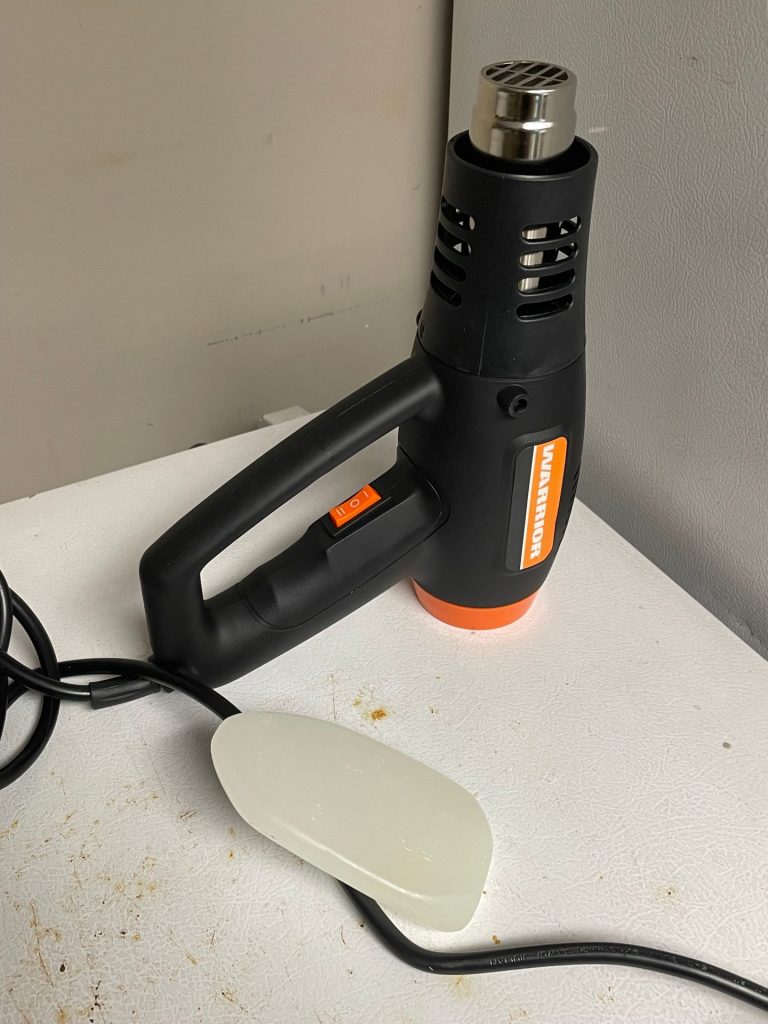
One is a jacket that’s made of a woven textile. Cotton canvas and denim are two materials that take well to wax.
I have no experience waxing synthetics, but I wouldn’t. Do not wax wool.
If you’re not sure what to wax, just get a cotton jacket and do that. I know from experience that cotton takes well to waxing, and in fact, it protects and preserves the fibers.
In addition to the jacket, you’ll also need some wax. You can buy pre-made treatment, but the easy and effective way is to just get some paraffin. No need to go fancy here. You can get plain, unscented, undyed paraffin wax at any grocery or hardware store. They sell it with canning supplies. For this, I’m using a block of Gulf Wax. It’s dirt cheap and easy to find.
Of course, if you want to be really resourceful, you can go around and collect the scraps of wax from the bottoms of candle jars. These will work just as well, they’re free, and you’ll be saving wax from the garbage.
You will also need a way to heat the jacket or wax. I will be using a heat gun that I bought at Harbor Freight for less than 20 dollars.
By the way, an alternative method to mine is to melt the wax and then brush or sponge it on. This works, but there is a reason I prefer my method.
Using melted wax and a sponge or brush is a bit iffy. It’s easy to over apply the wax and in my limited experience you really don’t need to fully saturate the jacket. Remember, you can always put more wax on but you can’t take it off.
So basically, all you need are a jacket, a block of wax, and a heat gun.
How to Wax a Jacket
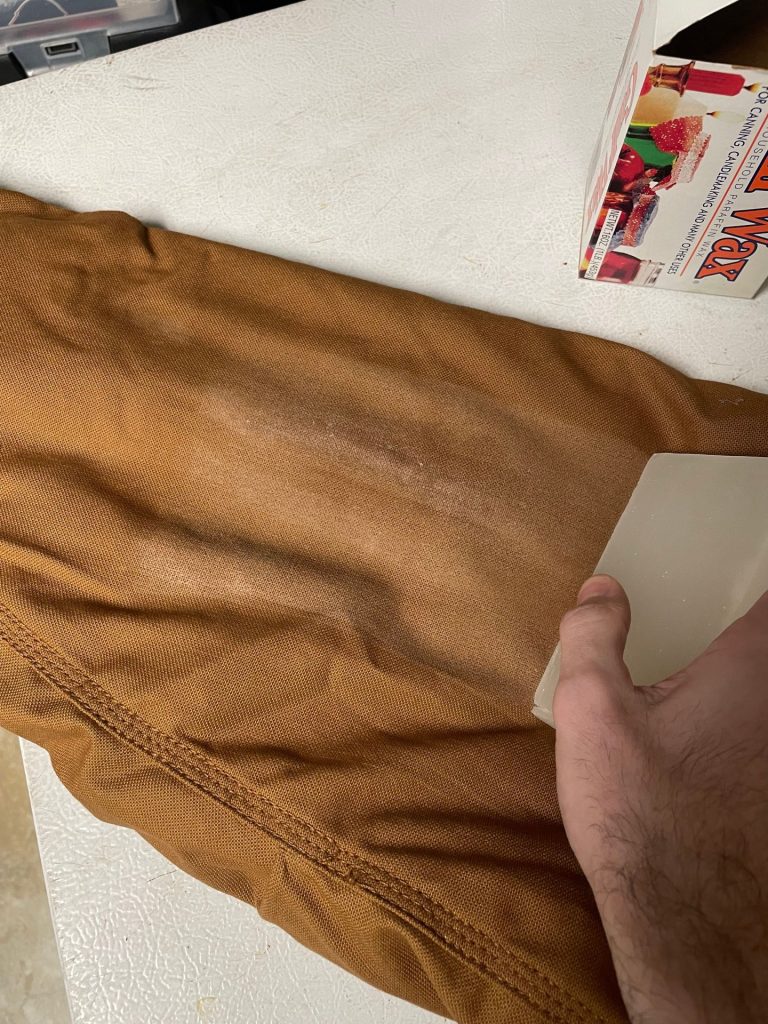
As for the process of waxing the jacket itself, it’s surprisingly easy, although it is a somewhat time-intensive process. I’d say it took me a good two hours of applying, heating, and applying a second coat before I was done.
If you’re working with a canvas jacket, you won’t need to heat up the coat or paraffin beforehand. The natural tooth of the textile is abrasive enough that you can simply rub the bar of paraffin back and forth on the coat and it will grate off onto the fabric.
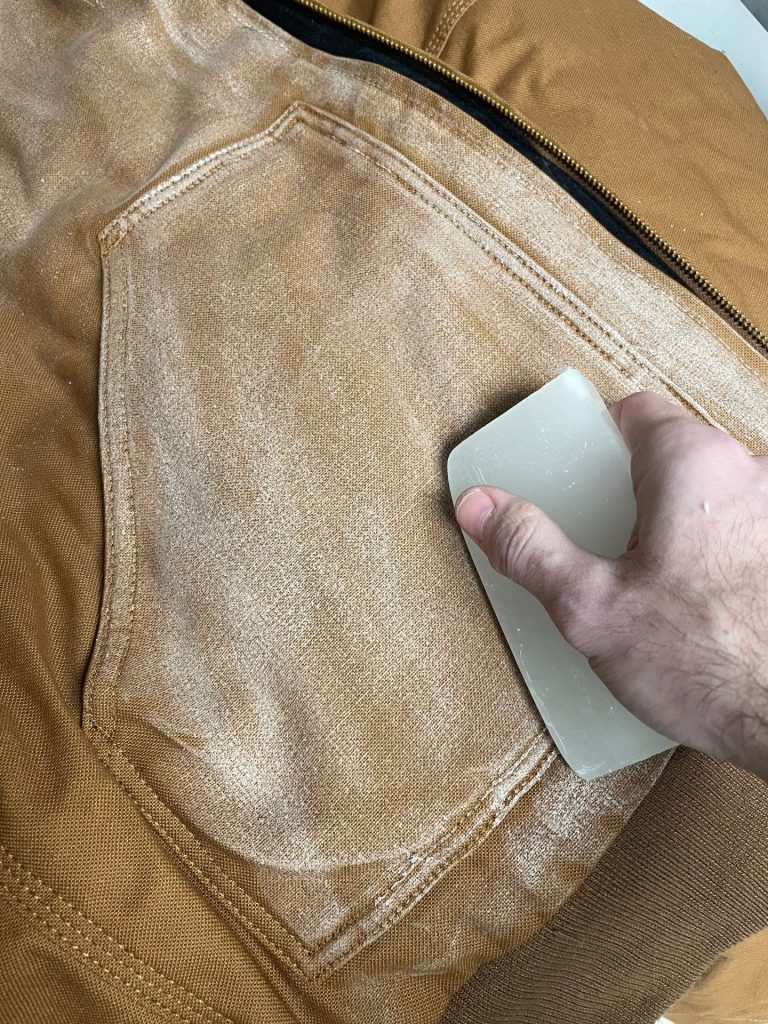
Rub your block of wax aggressively into the canvas fabric and you will see white streaks where the wax has come off the bar and been deposited onto the surface of the coat.
Work back and forth with the bar until you’ve left a nice, solid, white rubbing on the surface of the coat. Then, focus your attention to the seams. The seams are a weak area and very prone to absorbing moisture, so you will want to leave a heavy application of wax wherever there is stitching.

Once you have a good, solid white layer of wax scrubbed off onto the surface of the jacket, it’s time to break out the heat gun.
Set your heat gun on a setting that’s fairly low (to start with).I think my heat gun’s low setting is like 750℉ or so. That’s plenty.
Let the gun heat up and then start moving it back and forth over the area you waxed. Pause a moment or two in a spot and you will see the wax start to get shiny and melt. Give it a few more passes and you’ll see the wax start to soak into the fabric because it’ll get darker, like the picture below.

Pass over the area you waxed until all the wax “disappears” from the surface of the jacket, meaning it has soaked into the fibers.
With your first application, the color of the jacket won’t have changed too much if all all.
Now guess what?
Do it again.
Go back over the area you just waxed with the wax bar, applying a second coat. Again, give the seams a heavy helping of wax. Then, repeat the process with the heat gun, until all that wax has “disappeared” and sunk into the fabric.
I prefer to do this all in one area of the jacket, doubling up on the coat of wax until that area has been finished, before I move onto the next one.
Turn the jacket over a few times, making sure that you’ve fully covered every surface in wax and heated the wax to melt it into the fabric. You do not want to find out too late that you missed a spot – you’ll get soaked!
Once you’ve waxed the entire jacket and heated it properly, you’re set to test it all out. I only gave my jacket two light coats. As you can see in the image below, it is really hardly changed in appearance at all.
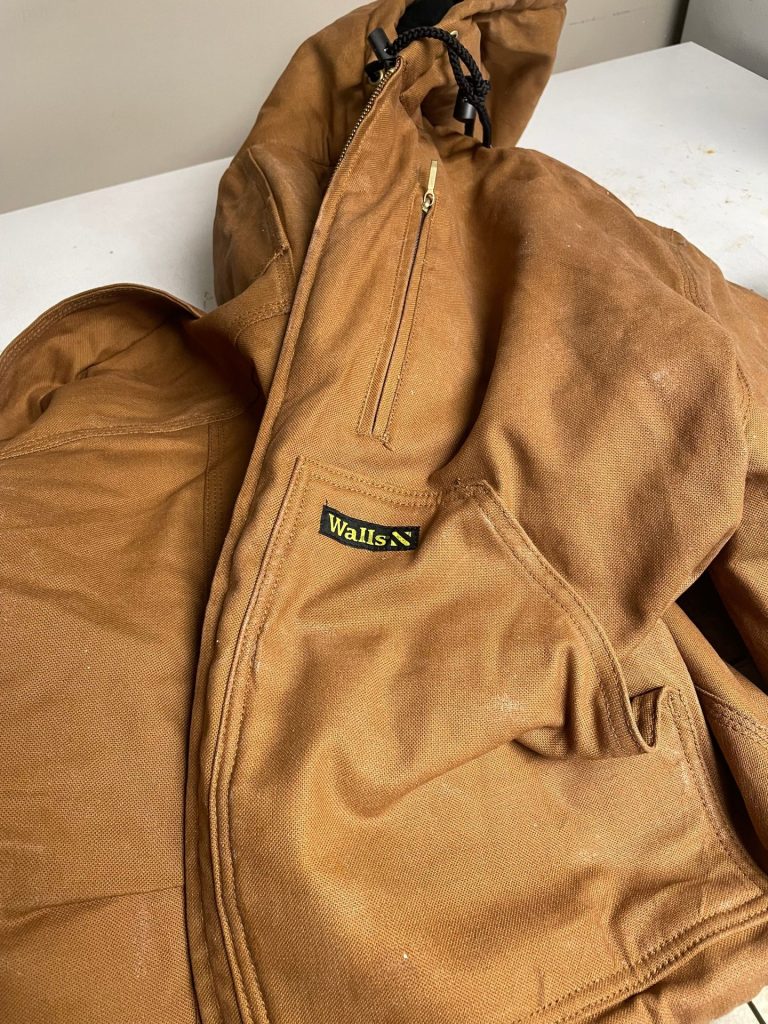
Be aware, though, if you follow the method of melting the wax and brushing it into the fabric, it will darken substantially.
Let the jacket cool and you’ll be ready to test your handiwork to see how it will hold up to proof – of being soaked.
I filled a spray bottle and gave it a good spritz to simulate fairly heavy rain. You can see in the picture how it reacts to getting wet.
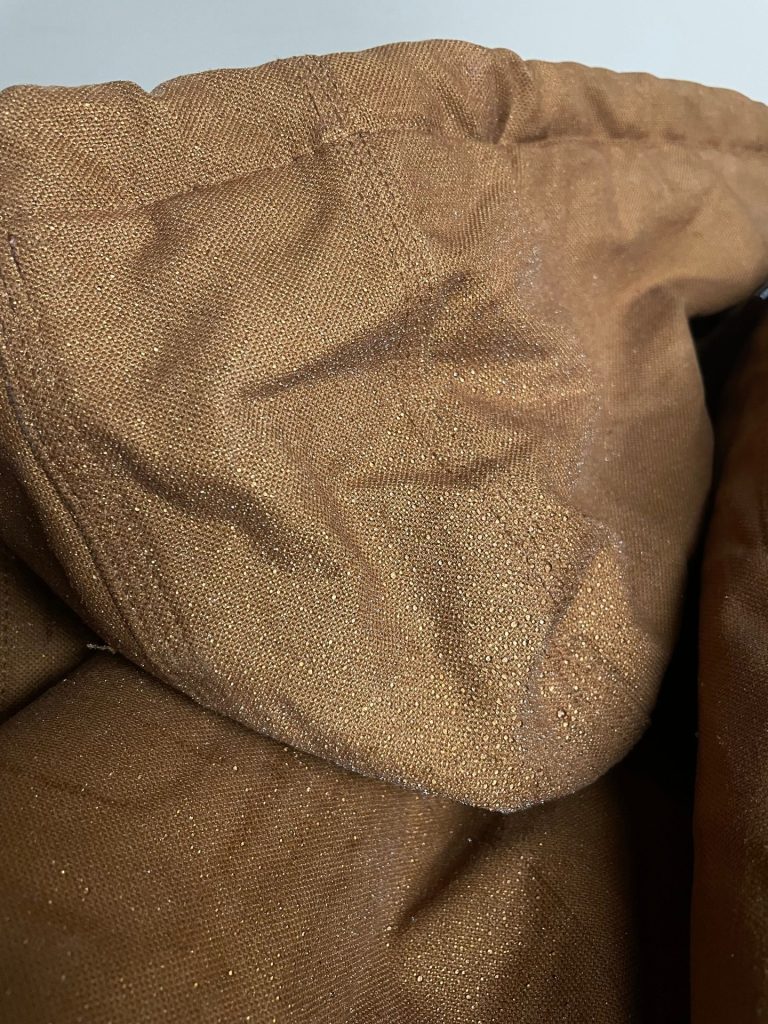
That’s the hood. If you zoom in on it you’ll see that the water has beaded up on the surface and will not sink into the fabric.
But how will she hold up to a heavier soaking?
I gave the jacket an even heavier spray to show how good this waterproofing is for the camera. Check it out below.
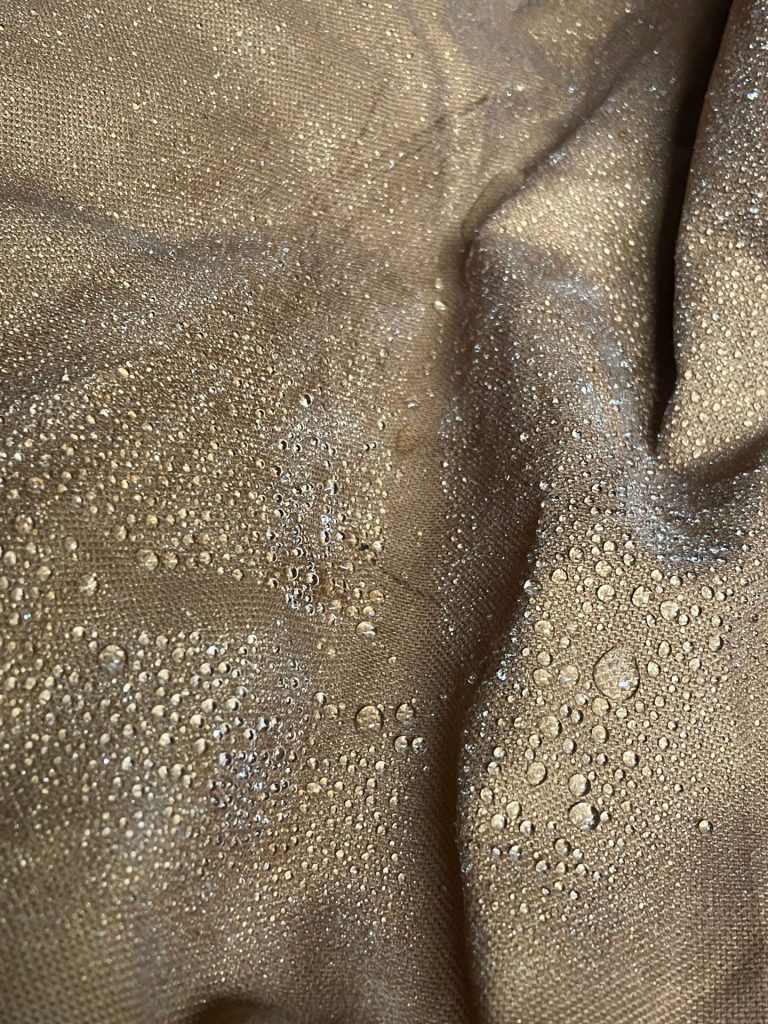
As you can see, the water just don’t not want to soak into the fabric. You can see just how effective the wax treatment is at preventing the fabric from getting wet.
That’s why you want to wax your jacket, and you’ll be glad you did if you ever wear one of these in the rain!
Disclaimer: You’ll Need to Do This Every Year or So
One thing I do want to point out is that over time, the wax coating will wear off and the jacket will lose the water-repellent properties you’ve given it.
I recommend that you wax your jacket anew at minimum once every year, although you be at liberty to do it as frequently as you see fit.
It bears noting, as well, that this is just a guideline. If you wear your jacket a lot, are hard on it, and live in an area with a heavy rainfall or snowfall, you may need to do it more often.
You know how to tell your jacket needs a touch-up? If you’re in the rain and you start to notice darkened patches on the jacket. This will indicate that the water has worked its way under the wax or found a proverbial chink in the armor and has sunken into the fabric.
If this happens, break out the wax and the heat gun and reapply exactly in the manner I described above.
Why Do It Yourself?
You can buy waxed jackets, and they’re pretty readily available. So why should you take the time and effort to do it yourself (for reference, it took me about two hours to wax the jacket that is the focus of this article).
Well, you can, but if you ever want to feel a strong sense of offense, just look up some of the waxed cotton jackets that are commercially available.
They’re outrageously expensive, with a premier option from L.L. Bean, Filson, or Barbour costing several hundred dollars.
While I did get an exceptionally good price on my jacket, even with the wax and heat gun I was in on this project for under $30 dollars.
I’d call that a bargain.
Plus, the other reason to do it yourself is to be certain of the quality. I’m sure there are manufacturers out there with brands to uphold who do a pretty good job, but you know the old saying.
Well, you know. See the top of this article.
Why a Waxed Jacket Is Simply Better
Now, allow me a few moments to close this whole thing out on a defense of waxing your jacket in the first place.
You can’t get the wax out, so it is fair to wonder if it is worth it or not. However, I daresay the answer is an unflinching, unadulterated, positively-resounding “yes.”
Obviously, waxing your coat will waterproof if. Since this is a cotton jacket, that can be a matter of comfort and hypothermia. I’ll take the former. A cotton jacket that’s been waxed will keep you dry and I say that alone is worth it.
But there are other pragmatic reasons to wax a jacket, too. One has to do with the durability of the fabric itself.
Don’t get me wrong, cotton canvas is a tough fabric. But if you’re hard on your coat, the fibers will fray, work loose, and fall out over time. It’ll take years, but it will slowly happen over time.
Waxing your jacket is like waxing your bowstring. It keeps the fibers together, and by preventing them from separating, strengthens them The wax binds then thin cotton strands together, making the canvas much more durable than it already is.
There are other reasons that a waxed jacket is better than an alternative, too. Take, for instance, one of those commercially available shells or ponchos.
Let alone the fact that they provide little to no insulation (and a waxed jacket can) if you ever get a hole in one of them, you’re cooked. Not only will you get wet, but it can’t be repaired.
If your waxed jacket gets a tear, you can stitch it right back up and just reapply the wax. It’s easy as pie, not to mention the fact that fabric is much more durable than PVC and whatever other cheap synthetics are used to make those raincoats. Waxed jackets can be re-waxed to restore their waterproofing; raincoats cannot.
And, by the way, do you know the reason that most raincoats are colored bright yellow? That’s to preserve the aesthetic of the original oilskins; which, by the way, were made with linen (and later cotton canvas because it was more durable) treated with linseed oil which waterproofed them.
As the linseed oil oxidized, it turned a rich, deep yellow color. That’s the reason why your stereotypical raincoat, even today, is bright yellow.
It’s just ironic that the first oilskins were basically waxed canvas, and only later were replaced with inferior plastic alternatives (most likely because plastic is cheaper).
Incidentally, waxed canvas also repels other liquids that would leave a stain and prevents dirt, dust, and other oils from sinking in easily, which helps keep the fabric cleaner and nicer for longer – but that’s more or less aesthetic and not functional.
On another aesthetic note, waxed fabrics, like canvas, will develop a rich, beautiful patina over time, much in the same way that full grain leather boots will.
That’s another reason to go with waxed fabric over a synthetic alternative.
In a nutshell, it’s just as effective, much tougher, can be re-waterproofed, and has superior aesthetics. That’s four solid advantages right there.
Now get to it and wax your own jacket. Just remember that once waxed, you can’t go back.
Stay dry.
~The Eclectic Outfitter